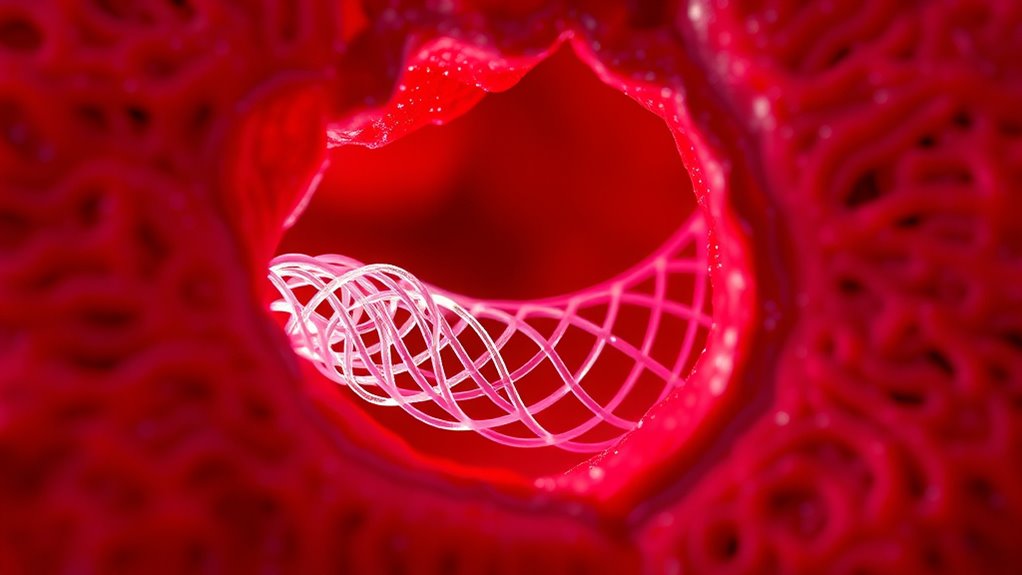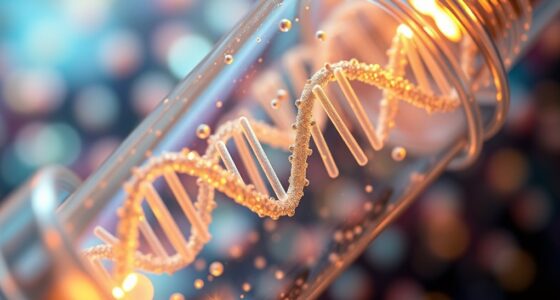Polymer chemistry is revolutionizing heart surgery by enabling the creation of biodegradable stents that support blood vessels temporarily and safely dissolve afterward. These advanced materials are designed to control degradation rates, releasing drugs to prevent restenosis and reduce complications. As they break down into biocompatible byproducts, they minimize long-term issues linked to permanent implants. If you keep exploring, you’ll discover how these innovations are making heart treatments safer and more effective than ever.
Key Takeaways
- Polymer chemistry enables the design of biodegradable stents that safely dissolve after supporting blood vessels.
- Advanced polymers allow controlled degradation rates, matching healing timelines and reducing long-term complications.
- Drug-eluting coatings on biodegradable stents release medication gradually, preventing restenosis effectively.
- Biodegradable materials break down into biocompatible byproducts, minimizing inflammation and adverse reactions.
- The integration of polymer science with medical device design is revolutionizing minimally invasive, personalized heart treatments.

Have you ever wondered how medical devices like stents are evolving to become safer and more effective? Today, advances in polymer chemistry are transforming traditional metal stents into biodegradable options that better serve patient needs. These innovative stents are designed to support blood vessels temporarily and then safely dissolve, reducing long-term complications.
One key feature that makes them so promising is their drug eluting properties. Unlike bare-metal stents, biodegradable stents can be coated with medications that are released gradually, directly targeting the site of arterial blockage. This controlled drug delivery helps prevent restenosis, or the re-narrowing of arteries, by inhibiting excessive tissue growth around the stent. As a result, patients experience fewer repeat procedures and improved overall outcomes.
Biodegradable stents release medication gradually, reducing restenosis and improving patient outcomes.
A major challenge in developing these stents lies in managing material degradation. The materials used must maintain sufficient strength during the critical healing period but then break down safely once their job is done. This balance is delicate—if the material degrades too quickly, the stent might collapse before the artery heals; if it degrades too slowly, it could cause inflammation or interfere with natural vessel function. Material design plays a crucial role in overcoming these challenges.
Advances in polymer chemistry have enabled scientists to design materials with predictable degradation rates, ensuring that the stent provides support for just the right amount of time. These polymers are engineered to break down into biocompatible byproducts that the body can easily eliminate, minimizing inflammation and other adverse reactions. Additionally, material properties such as polymer composition and cross-linking are key factors that influence how the degradation process unfolds.
The process of material degradation is carefully controlled through the molecular structure of the polymers. By tweaking factors like polymer composition and cross-linking density, researchers can fine-tune how long the stent lasts and how it interacts with the surrounding tissue. This precise control is essential because it directly influences both the safety and efficacy of the device.
Furthermore, the degradation process can be synchronized with drug release, creating a synergistic effect where the stent provides mechanical support while simultaneously delivering medication. As the polymer gradually dissolves, it continues to release drugs, providing ongoing therapeutic benefits even after the stent itself has vanished.
In essence, the integration of drug eluting properties with advanced material degradation techniques is revolutionizing how we approach heart surgery. These biodegradable stents not only reduce the risks associated with permanent implants but also open new avenues for personalized and minimally invasive treatments.
Thanks to ongoing innovations in polymer chemistry, you can expect these devices to become safer, more efficient, and more tailored to individual patient needs in the near future.
Frequently Asked Questions
How Long Do Biodegradable Stents Typically Last Inside the Body?
You might wonder how long biodegradable stents last inside your body. Typically, their material durability allows them to support your artery for about 3 to 6 months.
The degradation timeline varies depending on the polymer used, but generally, these stents gradually break down within a year.
This controlled degradation helps restore normal blood flow without leaving permanent implants, reducing long-term complications and promoting healthier artery healing.
Are There Any Long-Term Risks Associated With Biodegradable Stent Degradation?
Is the phoenix’s ash a symbol of renewal or risk? Long-term, you might worry about implant longevity and potential harm from degradation byproducts.
While biodegradable stents are designed to safely dissolve, incomplete degradation or unexpected reactions could pose risks. You should stay informed on ongoing research and discuss concerns with your doctor, ensuring that the benefits outweigh any potential long-term effects of the degradation process.
What Materials Are Most Commonly Used in Biodegradable Polymer Stents?
You’re curious about what materials are most common in biodegradable polymer stents. Typically, they use biocompatible materials like polylactic acid (PLA), polyglycolic acid (PGA), and polycaprolactone (PCL).
These materials balance polymer durability and biocompatibility, ensuring the stent maintains strength during healing while safely degrading over time. This careful material selection minimizes long-term risks, making the stents safer and more effective for your heart health.
How Do Biodegradable Stents Compare Cost-Wise to Traditional Metal Stents?
You’ll find that biodegradable stents often have higher manufacturing expenses initially, leading to a steeper cost comparison with traditional metal stents.
However, over time, their benefits like reduced need for follow-up surgeries can lower overall healthcare costs.
While upfront prices may be higher, the potential for decreased long-term expenses makes biodegradable stents a promising alternative, especially if you’re considering the full scope of treatment and recovery.
Can Biodegradable Stents Be Customized for Individual Patient Needs?
Imagine a patient with a unique arterial structure; personalized design and material customization make biodegradable stents achievable. You can tailor these stents to match individual needs by adjusting polymer composition and shape, ensuring ideal fit and function.
This customization enhances healing and reduces complications, demonstrating that biodegradable stents can indeed be adapted for each patient, ultimately advancing personalized heart care through innovative material engineering.
Conclusion
As you embrace the future of heart surgery, remember how Phaethon dared to seize the chariot of the sun—boldly transforming the landscape of possibility. Just like him, biodegradable stents harness the power of polymer chemistry to revolutionize treatments, offering hope and healing that fade gracefully over time. With each innovation, you’re not just witnessing progress—you’re part of a story where science and compassion unite to reshape lives for the better.









